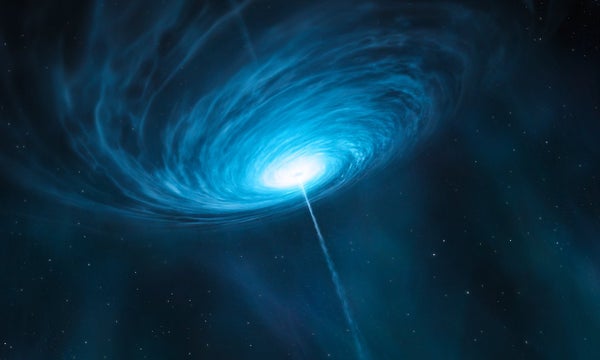The center of any galaxy is a hazardous home. There, supernovae explosions shower nearby planets with x-rays, gamma rays and ultraviolet photons that obliterate any ozone layer present. Gamma-ray bursts hurtle even more damaging shock waves, blasting any biosphere into oblivion. Even encounters with nearby stars knock planets around, driving them out of their habitable zones. “We don’t expect life to be easy within the inner kiloparsec of the Milky Way,” says Abraham Loeb from the Harvard–Smithsonian Center for Astrophysics. But now we can add one more menace to the list that tops the rest: supermassive black holes.
Every large galaxy’s center hosts a supermassive black hole that is wont to throw wild tantrums in its youth. Although many astronomers have speculated these behemoths, called quasars when they are active, would likely wreak havoc on any nearby planets, no one had taken a quantitative look at those effects—until now. A new study, posted on the preprint server arXiv and submitted to Monthly Notices of the Royal Astronomical Society, provides the first calculations that show when, where and how planets are harmed by quasars. And the quota alone is surprisingly high. Loeb and his postdoctoral researcher, John Forbes, found half the planets throughout the universe have lost the equivalent of Mars’s atmosphere, 10 percent have lost the equivalent of Earth’s atmosphere and 0.2 percent have lost the equivalent of Earth’s oceans—all thanks to quasars alone.
Although quasars are known to drive strong winds and jets of relativistic particles that can be dangerous in their own right, Forbes and Loeb looked at the damage caused by their light alone. The accretion disk of debris that orbits the black holes, funneling gas and dust in, are so bright they can outshine all the stars in their galaxies, which are 100,000 times larger. And when that light illuminates the atmosphere of a planet, the high-energy photons transfer energy to those atmospheric particles, giving them the boost to escape the planet’s gravitational pull altogether. Outside experts like Duncan Forgan from the University of Saint Andrews in Scotland are quick to point out the amount of loss depends greatly on the atmosphere’s composition and the planet’s mass. This finding is one piece in a several-million-piece, three-dimensional puzzle, he says, but nonetheless it is still that crucial first piece.
On supporting science journalism
If you're enjoying this article, consider supporting our award-winning journalism by subscribing. By purchasing a subscription you are helping to ensure the future of impactful stories about the discoveries and ideas shaping our world today.
Should a planet lose its entire atmosphere, the results would likely be devastating to any life present because atmospheres play a crucial role in keeping liquid water around. Not only do they prevent solid ice from sublimating into vapor, they also shield planets from harmful radiation and help regulate surface temperatures within a stable range. It is for these reasons that it is thought Mars lost the potential to harbor surface life when it lost its atmosphere billions of years ago. But Dave Brain from the University of Colorado Boulder, who was not involved in the study, notes that occasionally the loss of an atmosphere can actually helplife. Take Earth as an example. Our abode’s early atmosphere was dominated with hydrogen and helium—two elements not exactly known for their life-supporting characteristics. Fortunately, the sun eroded that atmosphere and volcanoes, along with subsequent organic activity, replenished it with the life-friendly gaseous mix that is present today. Still, Brain thinks the loss of an atmosphere is only beneficial in the rarest of circumstances. For the most part, atmospheres are advantageous to life and losing one will likely sterilize a planet. Thus the new findings could be detrimental to life’s chances across the galaxy.
Luckily for us, the Milky Way’s supermassive black hole, Sagittarius A*, has not wreaked havoc on the atmospheres on Earth and Mars. Forbes and Loeb think the solar system is protected by its distance from the galactic center. “It’s not surprising that we have life here on Earth,” Loeb says. As such, the results shed light on the so-called galactic habitable zone—that band around a galaxy where life is likeliest to emerge. Typically, this band has been calculated based on supernovae explosions, gamma-ray bursts and even metallicity, but never the distance from the quasar. Past models have ignored the innermost kiloparsec, Forgan says, because astronomers were not sure how to take into account the supermassive black hole. He is excited to see the new results, he says, because they will force him to carefully reconsider what is happening at the galactic center.
The study does not just look at habitability across vast cosmic distances; it also examines lengthy cosmic timescales. Because supermassive black holes tend to throw their tantrums in their youth, planets are likely to be more affected the farther back in time you look. “It's another interesting perspective of why we’re here at this point in time,” Forgan says. “Maybe there’s an indication that the universe was simply less habitable in the past and that we’ve arrived just at the point where life becomes fairly common.” As such, older planets might be more likely to be sterile today. That idea stands in stark contrast with the conventional idea older planets are promising places to search for life, given that they would be more likely to have enough time to develop civilizations, Forbes says.
“This has implications for science fiction movies all over the place,” Brain says. “I don’t think you can place your civilization at the galactic center anymore.” Then again, a civilization that has to survive the hazards of a supermassive black hole in the early universe might be a movie script in the making.
